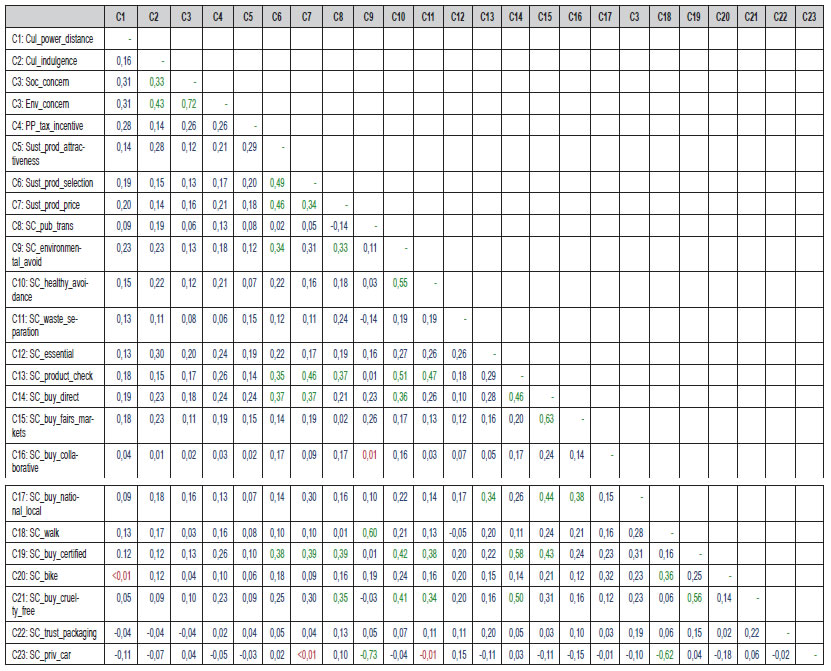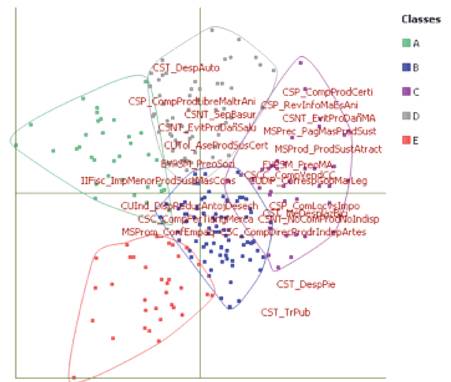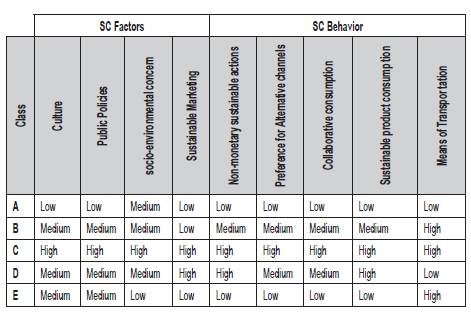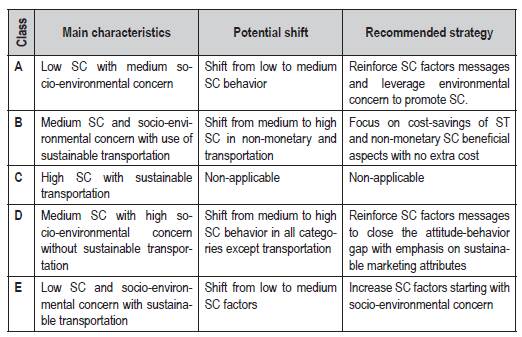According to a study carried out by the World Business Council of Sustainable Development in 2008, in all countries surveyed -including Germany, Canada, China, United States, France, India, Mexico, Russia and the United Kingdom- consumers acknowledge their responsibility to the environment and take concrete actions on a daily basis to reduce their consumption and waste. In Mexico in particular, in 2014, 76% of the population surveyed said they were concerned about the environment and social context, which represents an increase of 12 % compared to 2009 (GlobeScan and National Geographic 2014).
At the same time, the World Council of Sustainable Development anticipates that the global middle class should triple by 2030 and reach four billion people in 2040, that is, 44 % of the world population (World Business Council of Sustainable Development 2008).
Consequently, the total income available in this sector of the population would increase significantly and could become a new challenge for a sustainable world if this is associated with a replication of current intolerable consumption patterns. Indeed, the actual human footprint on natural resources exceeds by 25 % the regeneration biocapacity of the Earth, which could reach 70 % in 2040, if there is change in current consumption trends (World Business Council of Sustainable Development 2008). Therefore, it is critical and urgent to investigate SC in emerging countries to understand how it could be customized, encouraged and widely adopted to avoid high carbon economical transitions, and lead to low carbon economies.
However, so far, the SC phenomenon has been primarily documented in developed countries where its growth has been exponential during the last two decades (García and Poole 2009). As a result, related investigation, understanding, profiling and modeling knowledge is mainly associated with those regions (Dueñas Ocampo et al., 2014; Papadopoulos et al. 2010). This geographical limitation is expressed by different researchers, such as Francois-Lecompte and Roberts 2006; Garcia and Poole 2009; Papadopoulos et al. 2010; Akehurst, Afonso, and Gonçalves Martins 2012; Dueñas Ocampo et al. 2014), which leads to questions on how to strengthen SC in diverse cultures and lifestyle contexts. this is especially the case, since socio-environmental concern is now also highly visible in emerging markets where SC options are expanding.
Globally, young adults are the most prone to consume in a sustainable way. Indeed, "millennials" or the "Y generation" -to designate people born between 1982 and 1995-, are most willing to pay a premium price for food with benefits (81 %), and have a strong propensity to consider fair trade (38 %) and organic (36%) attributes as very important in their purchase decisions. (Nielsen 2015).
Mexico is a relatively young country with 45 % of the population aged less than 30 years in 2015 (Wulf 2015), in an emerging Latin American region where in 2016, one third of the population was considered as millennials (Gutiérrez-Rubí 2016) -i.e., people aged 20 to 34 years old-, it is pertinent to perform a study in this country.
Thus, we propose to analyze in depth the SC specificities of a population matching the elements noted above: living in an emerging country, Mexico, and pertaining to millennials, such as young adults. This will provide new insights on the way this population consumes in a sustainable way, on factors that could influence their behaviors, and identify the characteristics that enable the definition of distinct groups of consumers, which is to say, the segmentation criteria applicable to them. The following research offers a first proposal of the SC patterns of young adults living in Mexico City.
Theoretical background
Consumption and sustainability are broad concepts. To establish the scope of this study, it would be convenient to define what they will refer to herein. First, according to García Canclini (2006) consumption refers to "the set of sociocultural processes through which products are appropriated and used". It then deals with both the acquisition and utilization of goods. Secondly, sustainability, with its Latin roots, refers to permanence, maintaining, avoiding decline. In the 1987 Brundland report, sustainable development was defined as something "that meets present needs without jeopardizing the ability of future generations to meet their own needs" (Brundtland 1987). Thus, SC will be the association of both, combining the way people get and use products with the preservation of the Earth's resources.
According to Greenpeace México (n. d.), SC is based on three criteria: first, geographical proximity between the producer and the consumer; second, a production process that minimizes or eliminates the use of chemicals and water inputs, and allowing the maintenance of ecosystems; and third, an equitable distribution of profits with workers and their communities through a relationship of dialogue and respect. In practical terms, Garcia and Poole (2009) define SC as consumption that privileges the purchase of products and services that have the least ecological impact and are socially responsible in their production, transformation and distribution process, while avoiding the purchase of products that have a negative impact on society or the environment). As such, all types of products can generate SC: food, housing, transport, technology, and diverse kinds of practices can become sustainable: purchasing, consuming, managing waste, etc.
SC implies different kinds of actions: at an individual and monetary level, it means a preference for local, organic, fair trade, environmentally friendly and animal careful products.
At an individual and non-monetary level, SC refers to the "5 R" actions for sustainability: Reduce consumption -which may be part of a globally simpler lifestyle (Papaoikonomou et al. 2011)-, Recycle, Reuse, Repair and Repurpose objects.
At a collective and monetary level, collaborative economy is involved through mutual or shared purchases (Robert et al. 2014) that help maximize the rate of use of products and extend durability when used by a company, association or public agency (Robert, Binninger, and Ourahmoune 2014). A social and solidarity economy is also an option, with the objective of serving human beings first (García-Chiang 2011), and buycott designs the viral and sometimes massive purchase of a product, in this case for presenting specific socio-environmental attributes.
Finally, at a collective and non-monetary level, products that do not meet city expectations may be boycotted by citizens (Shaw et al. 2006).
Other concepts of consumption based on socio-environmental aspects can also be mentioned such as responsible consumption, that is a rational and above all, conscious consumption by citizens who seek to make a difference personally or towards others, by changing a consumer behavior that causes social and environmental problems (Ulusoy 2015). This vision leads to a peculiar vision focused on behavior change, rather than on consumer practices per se. Another example is ethical consumption, defined by García and Poole (2009) as "the affirmation of the moral dimension of purchasing decisions", which involves principles of right and wrong, a very complex and individual appreciation (Carrington, Neville, and Whitwell 2014).
To quantify SC behaviors levels, it is necessary to divide sustainable consumers into discrete groups with similar characteristics. Segmentation also helps identify segments that require greater attention in terms of marketing and communication, and behavioral change potential (Rigby 2015).
Within existing segmentations, a classification was developed by Terra Choice in Canada (Ministère de l'économie des sciences et de l'innovation du Québec n.d.). However, it is incomplete as it only focuses on green attributes. Thus, we can differentiate among environmentalists who seek to reduce their ecological footprint as much as they can, the sensitized, who seek to buy as many green products as possible, followed by the masses who seek to adopt a green way of life the backward, who expect everyone else to adopt a green way of life to change their behavior, and finally, the polluters, who have no concern about the impact of their way of life on the environment.
Another example of segmentation based on SC involving both environmental and social dimensions, was developed by Ethnicity Groupe Greenflex (2014). It involves three large families of consumers. First, alternative consumption actors, who are the most involved in SC. Sensitive to sustainable development issues, they promote social values, healthy products, and expect a collective response to the planet's problems. Secondly, economically restricted people, who are aware of the need to preserve the planet and have good intentions, but their economic resources do not allow them to consume sustainably. Therefore, they prefer low prices and try to reduce their consumption. Thirdly, skeptics, who deny social and ecological realities and continue their behavior as is. For them, consumption is still a symbol of identity and particular interests prevail over general ones.
Main segmentation criteria include effective sustainable measurement actions, as well as the attitude toward sustainability issues.
The literature supplies another input on key factors that influence SC. For example, increases media coverage of these issues (Garcia and Poole 2009; Roberts 1996; Strong 1996). A better level of consumer information on environmental questions and inequality of world trade terms (Garcia and Poole 2009; Strong 1996), and greater corporate social responsibility (CSR) that pushes for a more socio-environmentally friendly offer (Biehal and Sheinin 2007). Others include the higher standard of living in developed countries that enable access to this offer (García and Poole 2009), institutional encouragement and public policies for a greener and more sustainable business (Giesler and Vere-siu 2014; Kilbourne, Beckmann, and Thelen 2002; Prothero et al. 2011) and the individual identity process (Ozcaglar-Toulouse 2005; 2007).
To form groups of consumers based on a wider perspective of SC that could help explain consumers' behavior patterns, we included diverse types of SC factors and SC behaviors in this research.
Methodology
This study is part of a larger doctoral investigation of SC. As such, it is based on a two-step's methodology that includes both a qualitative exploratory and a quantitative relational study.
Indeed, after reviewing the state of the art to identify and model the key factors that could influence SC among young adults in Mexico City, a first stage of the research consisted of in-depth interviews to evaluate the pertinence of the model proposed in the study population to refine the associated constructs and variables. We interviewed thirteen men and women, aged 20 to 34 in 2016, representing five social classes of Mexico, based on both judgmental and snowball sampling.
A questionnaire was developed that was derived from the exploratory phase, which included seventy-three questions that addressed five external SC factors (culture, institutional encouragement, lifestyle, social influence and sustainable marketing), three decision process constructs (affect, cognition and connation), and five types of SC behaviors (by products, by channel, by collaborative consumption, by non-monetary actions and transportation).
As the instrument was meant to perform both an exploratory and confirmatory factorial analysis, the target sample size was calculated with G*Power tool. The effect size (f2) considered was 0,05 (meaning a small effect, as SC remains low in Mexico), the error margin 0,5, the power 0,95 and 5 predictors (as it is the number of the up-mentioned key SC external factors). The resulting target sample size was 218. The achieved sample was finally over target, as we applied the questionnaire to 386 people, of whom 248 passed the age and city residence filters. The sample was non-probabilistic, and organized by gender (50% male, 50% female), age (1/3 from 20 to 24 years old, 1/3 from 25 to 29, 1/3 from 30 to 34) and income levels (five classes based on the national statistical institute INEGI standards).
We disseminated the questionnaire among students from different universities in Mexico City. Students from Universidad Nacional Autónoma de México (UNAM) represent the 42 % of the respondents, and students from Instituto Tecnológico de Estudios Superiores de Monterrey (ITESM) were 14 %. We also issued the questionnaire in public places such as Colonia Viveros de Coyoacan and Colonia Doctores -8 %-, and finally, through Facebook groups whose members matched the population study (Mexico city's universities, Mexico City's delegation neighbors, Mexico City's purchase and sales and Mexico City's job offers) -31 %-. Each time we shared the questionnaire we adopted an aleatory approach, meaning that everyone willing to participate could do so, as a way to diversify the profiles surveyed.
Finally, we administered the questionnaire through an online form processed by the SphinxDelic 2 tool.
Table 1
SC factors and variables for K-Means analysis
Source: Author's own creation, based on Picard (2020), Giesler and Veresiu (2014), Schiffman and Lazar Kanuk (2010), Kilbourne, Beckmann and Thelen (2002).
Table 2
SC types and variables for K-Means analysis
Source: Author's own creation, based on Picard (2020).
Based on the results of the confirmatory factorial analysis (Picard 2020), eight significant variables were retained for performing the present cluster analysis (see table 1), covering four determinant factors of SC: 1. culture, 2. public policies, 3. socio-environmental concern, 4. sustainable marketing.
We then measured five types of SC through sixteen variables in order to constitute SC behavioral patterns (see table 2). These are: 1. means of transportation, 2. non-monetary sustainable actions, 3. preference for alternative channels, 4. collaborative consumption, and 5. consumption of sustainable products.
We used a seven point Likert scale, depending on the characteristics of the questions (ranging from completely agree to completely disagree, and always to never) (see table 3).
As the goal of this statistical analysis was to generate groups of individuals to deepen the understanding of SC behavioral patterns, meaning that the more homogenous or different they were, the appropriate K-means centroid cluster analysis was selected, and performed by Sphinx Declic 2.
The number of classes was figured out automatically, based on the highest stopping criteria as the ratio of gains from n-1 classes move to n classes.
Results: Analysis and Discussion
The data input in the K-Means analysis shows an Alpha of standardized Cronbach of 0,83, a strong value within the range of acceptability, that is, greater than 0,7 and less than 0,9 (Cortina 1993). This indicator shows that the explanatory variables are highly correlated.
Table 3
Answers options
Source: Author's own creation, based on Picard (2020).
Means, as indicators of variable answer tendencies, show that all constructs are qualified from neutral to positive except for one variable, which is the use of a bike (see table 4). Considering skewness, despite a standard deviation that could indicate the contrary, as it is relatively high with an average of 1,49, we confirmed this tendency on the positive side of the answers as the distribution of values is mainly distributed on the left side of the graph. Indeed, Kurtosis shows that the distribution of answers varies, depending on the construct. Finally, the standard deviation indexes are totally acceptable (Tambwekar 2009).
Based on the correlation matrix (see table 5) we can obtain a first analysis of SC behavioral patterns. First, the correlation between social and environmental concerns is highlighted, with a coefficient of 0,72.
Secondly, we observed a correlation between buying in fairs and small markets and buying directly from producers, artisans or independents, with a correlation of 0,63, meaning a consistent behavior of preferring alternative channels. Equally, people who buy directly from producers also tend to buy local or national versus imported (0,44), buy certified products (0,43), and avoid ingredients that are harmful to the environment (0,36), showing that in some cases SC can be considered as a diverse set of actions.
Table 4
Variable characteristics
| Variable code | Mean | Min | Max | Standard deviation | Skewness | Kurtosis | Standard deviation index |
|---|---|---|---|---|---|---|---|
| Cul_power_distance | 5,44 | 1,00 | 7,00 | 1,33 | -0,87 | 0,79 | 0,29 |
| Culjndulgence | 5,15 | 1,00 | 7,00 | 1,38 | -0,57 | 0,03 | 0,31 |
| Soc_concern | 5,83 | 1,00 | 7,00 | 1,12 | -0,81 | 0,65 | 0,34 |
| Env_concern | 5,93 | 1,00 | 7,00 | 1,02 | -0,87 | 1,40 | 0,26 |
| PP_tax_incentive | 5,66 | 1,00 | 7,00 | 1,24 | -1,06 | 1,58 | 0,28 |
| Sust_prod_attractiveness | 4,62 | 1,00 | 7,00 | 1,24 | 0,02 | 0,29 | 0,25 |
| Sust_prod_selection | 4,41 | 1,00 | 7,00 | 1,57 | -0,21 | -0,45 | 0,31 |
| Sust_prod_price | 4,56 | 1,00 | 7,00 | 1,26 | -0,41 | 0,54 | 0,20 |
| SC_pub_trans | 4,71 | 1,00 | 7,00 | 2,06 | -0,52 | -1,15 | 0,50 |
| SC_environmental_avoidance | 3,92 | 1,00 | 7,00 | 1,43 | -0,10 | div -0,33 | 0,26 |
| SC_healthy_avoidance | 4,69 | 1,00 | 7,00 | 1,60 | -0,39 | -0,53 | 0,32 |
| SC_waste_separation | 5,61 | 1,00 | 7,00 | 1,57 | -1,03 | 0,17 | 0,40 |
| SC_essential | 4,85 | 1,00 | 7,00 | 1,51 | -0,42 | -0,44 | 0,29 |
| SC_product_check | 3,93 | 1,00 | 7,00 | 1,66 | 0,06 | -0,63 | 0,35 |
| SC_buy_direct | 4,14 | 1,00 | 7,00 | 1,36 | -0,16 | -0,19 | 0,23 |
| SC_buy_fairs_markets | 4,62 | 1,00 | 7,00 | 1,39 | -0,41 | -0,07 | 0,28 |
| SC_buy_collaborative | 3,30 | 1,00 | 7,00 | 1,77 | 0,20 | -1,07 | 0,40 |
| SC_buy_national_local | 4,42 | 1,00 | 7,00 | 1,24 | -0,41 | 0,31 | 0,23 |
| SC_walk | 4,39 | 1,00 | 7,00 | 1,55 | -0,52 | -0,43 | 0,30 |
| SC_buy_certified | 3,79 | 1,00 | 7,00 | 1,43 | -0,21 | -0,56 | 0,33 |
| SC_bike | 2,43 | 1,00 | 7,00 | 1,65 | 0,96 | -0,15 | 0,42 |
| SC_buy_cruelty_free | 3,87 | 1,00 | 7,00 | 1,76 | 0,02 | -0,95 | 0,39 |
| SC_trust_packaging | 4,54 | 1,00 | 7,00 | 1,45 | -0,41 | -0,24 | 0,26 |
| SC_priv_car | 3,97 | 1,00 | 7,00 | 2,15 | 0,02 | -1,44 | 0,51 |
Source: Author's own creation, based on Picard (2020).
Likewise, people who care about avoiding this kind of ingredients also buy certified products (0,42), plus, logically, people who buy certified products are interested in a sustainable offer and find it attractive (with a correlation coefficient of 0,38) and are willing to pay for it (0,39).
Thirdly, it appears that the inclination to avoid a craving consumption, a variable that represents in this study the Mexican indulgence cultural dimension as per Hofstede (2017), was influenced by the environmental concern with a correlation between both variables of 0,43.
Finally, a contrary correlation was found between the use of a private car and public transportation (-0,73) as well as walking (-0,63), showing that within the studied population, private transport usually excludes other means of transportation.
The number of classes retained for the k-means classification is five in the second step of the analysis due to the best stopping criteria identified in table 6. Indeed, the discriminating power of the gains ratio by adding a fifth class versus having only four is 2,12, which justifies stopping there. This class number enables a discriminating power of 0,30.
Based on this, the K-means classification consisted of five classes named A to E, as shown in figure 1.
According to table 7, the classes breakdown is acceptable as the frequencies are well distributed (with a concentration of 0,19 to 0,22), and the classes are homogenous (average standard deviation of 1,27) and distant from each other (average distance of 5,76 to 6,89).
Looking at the detail of the breakdown of classes (see table 8), and mean values of the variables for each class (see table 9), a typology of SC behavior patterns can be created.
First, we have class A, with 14 % of the respondents, a group of people characterized by the use a private car, with a low SC in all types: by products, by preference for alternative and collaborative channels, non-monetary, and logically transportation. However, the level of socio-environmental concern reported is relatively high (5,77 and 5,46), although below the sample average. The other three factors are also scored below average, and at a lower level (culture, public policies and sustainable marketing). Class A can then be called Low SC with medium socio-environmental concern. Class A's potential to shift to another SC level could depend on raising awareness of socio-environmental issues and the potential effects of individual behavior on it.
Secondly, there is class B with 33 % of the respondents (the most numerous class), which scored medium in SC factors with a medium SC behavior. It is noticeable that these groups report a low level of SC but do use public transport or walk. Their socio-environmental concern is high although they have little interest in buying sustainable products nor are they willing to pay more for them. Thus, class B is called Medium SC and socio-environmental concern with use of sustainable transportation. As they do not show an interest in sustainable products, there is potential in this group to shift from a medium to a high level of SC behavior in the non-monetary category, by focusing on its beneficial aspects with no extra cost.
Table 6
Breakdown of classification
| Number of classes | Discriminating power | Stopping criteria |
|---|---|---|
| 1 | 0 | |
| 2 | 0,14 | 1,82 |
| 3 | 0,21 | 1,43 |
| 4 | 0,27 | 1,47 |
| 5 | 0,30 | 2,12 |
| 6 | 0,32 | 0,78 |
| 7 | 0,34 | 1,55 |
| 8 | 0,36 | 1,83 |
| 9 | 0,36 | 0,39 |
| 10 | 0,38 | 0,00 |
Table 7
Quality indicators of the classification
Thirdly, class C, which corresponds to 15% of the respondents, scored high in all SC factors and SC types, without using a private car. As it showed the highest level of SC, it was called High SC with sustainable transportation. Class C's potential to shift to another SC level is low, as it already scores high in effective sustainable behavior.
Fourthly, class D included 24 % of the respondents and shows a medium to high level of SC factors. The effective SC behavior of class D is considered medium, except for transportation, due to the excessive use of a private car compared to public transportation, biking or walking. Class D was therefore called Medium SC with high socio-environmental concern without sustainable transportation. Given class D's interest in sustainable marketing attributes, there is potential to move from a medium to a high level of SC, especially in terms of sustainable products consumption and alternative channel preference, by focusing on socio-environmental concern and benefits. However, it would seem to be more complicated to promote sustainable transport among this class, due to the current high level of use.
Fifthly, class E included 13% of the respondents and scored medium to low in terms of SC factors and low in behavior, except for transportation as it uses sustainable transport and walking. Thus, class E is called Low SC and socio-environmental concern with sustainable transportation. Given its low level of SC factors, a shift to higher SC consumption appears complicated. Instead, it would be necessary to first improve SC factor levels, starting by raising awareness and concern about socio-environmental issues and as such, input, as a preliminary requirement for SC effective behavior.
In table 9, we can see that the influence of SC factors on SC behavior is noticeable. Indeed, SC factors appear to be a prerequisite for SC behavior, as SC behavior levels are always equal or inferior to those of SC factors. However, having favorable SC factors is not systematically represented by the same level of SC behavior.
Derived from the analysis of the main characteristics of the classes, table 10 provides a recapitulation of the potential shift of classes in terms of SC. These are recommendations are stated per class, to reach the next higher level of SC by leveraging the main characteristics and specificities of each group of consumers.
Looking back at the breakdown of classes (table 8), all respondents agreed that they worry about socio-environmental issues. The difference between high, medium and low levels (table 9) depends on whether they completely, strongly or simply agree with the affirmations.
This confirms the findings of the GlobeScan and National Geographic study (2014) that indicated a high level of concern for such questions in Mexico, and highlights the necessity of adopting large rating scales to enable an accurate interpretation of results.
Table 8
Breakdown of classes*
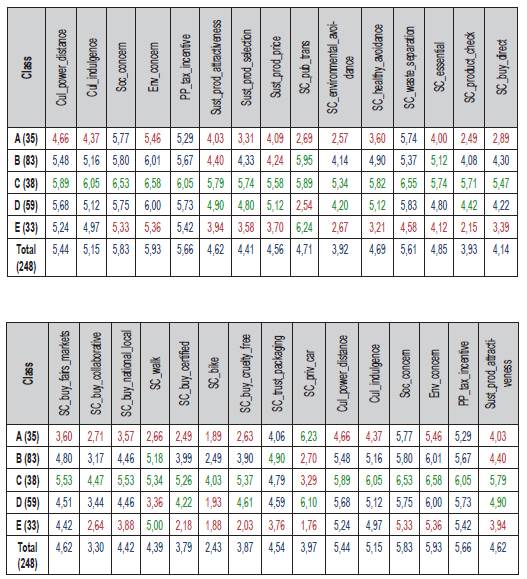
* (In green, significantly higher than the mean, in red lower, according to the meaning of the t-test at 0,05%).
In addition, it shows that people who report the highest socio-environmental concern, also practice the highest SC. While on the contrary, people who report the lowest concern, also practice the lowest SC. A correlation that reinforces the importance of creating awareness in populations to encourage a higher level of SC. On the other hand, transportation appears to be separate from the other types of SC, and probably reflect instead an individual's level of income for the population studied.
